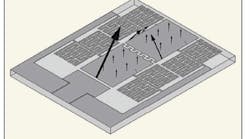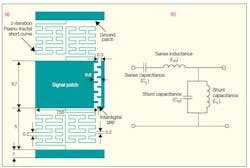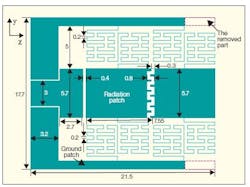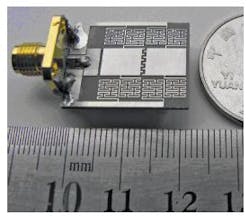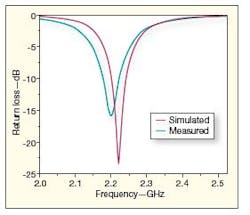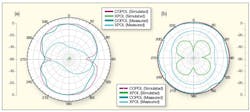As wireless communications applications expand, demand increases for compact antennas capable of supporting reliable communications. The current researchers worked with composite right/left-handed (CRLH) transmission lines to create a form of antenna building block. This unit cell was formed by inserting an interdigital gap and 2-iteration Peano-fractal short curves into a coplanar-waveguide (CPW) type structure. Based on analysis of the circuit parameters of these cells, they can be used to design compact zero-order-resonant (ZOR) antennas with wide bandwidths. To prove the point, a two-unit-cell ZOR antenna was constructed based on the CRLH transmission-line approach. It was found to have smaller size and wider bandwidth than other reported CRLH resonant antennas.
Because of the rapid expansion of wireless applications, interest has grown considerably in the use of metamaterials for microwave applications.1,2 Metamaterials are artificial materials not necessarily found in nature, engineered to provide specific properties by means of their structures and not by their compositions. For their engineered electromagnetic (EM) properties, metamaterials have been applied to work on antennas and terahertz (THz) frequency components.
For microwave applications, forming transmission lines based on left-handed metamaterials has led to the realization of composite right/left-handed (CRLH) transmission lines with attributes of both left-handed and right-handed transmission lines.3 CRLH transmission lines have many unique properties, such as supporting a fundamental backward wave and zero propagation constant at a given discrete frequency. By using the backward-wave property, CRLH transmission lines can be applied to the creation of dominant-mode leaky-wave antennas radiating both backward and forward.4
Due to the zero propagation constant property, the resonator has an infinite wavelength and its resonant frequency is independent of the physical size of the antenna structure. Therefore, CRLH zero-order-resonant (ZOR) antennas are more compact than conventional half-wavelength antennas.,sup>5-7 By applying the novel CRLH transmission lines detailed in this report, it is possible to design wideband ZOR antennas that are suitable for numerous wireless applications.5-9
The novel CRLH transmission line is formed by inserting an interdigital gap and 2-iteration Peano-fractal short curves into a CPW circuit structure [Fig. 1(a)]. The circuit is fabricated on a 1-mm-thick F4BM-2 woven-glass-filled, polytetrafluoroethylene (PTFE) copper-clad substrate with relative dielectric constant of 2.2. Figure 1(b) shows the equivalent-circuit model of the unit-cell structure used in this circuit. The series capacitance and shunt inductance are provided by the interdigital gap and 2-iteration Peano-fractal short curves, respectively. The CRLH transmission line is realized by cascading N required cells.
1. These diagrams show (a) the basic configuration of the novel CRLH transmission-line unit cell (with dimensions in millimeters) and (b) its equivalent-circuit model.
Work performed in ref. 10 found that the resonant frequency and bandwidth of the CRLH ZOR antenna were directly proportional to combinations of the shunt inductance, LL, and the shunt capacitance, CR, of the CRLH transmission lines—namely, 1/LLCR and LL/CR, respectively. As a result, a large value of shunt inductance, LL and a suitable value of shunt capacitance, CR, can yield a CRLH ZOR antenna with both small size and large bandwidth. The other circuit parameters are the series capacitance, CL, and the series inductance, LR.
The use of the 2-iteration Peano-fractal short curves enable a large value of LL to be realized in a small space. In the present design approach, the signal patch and ground plane are coplanar on the circuit board so that a suitable value of shunt capacitance, CR, can be achieved. In this way, CRLH transmission lines are used with this design approach to design compact ZOR antennas with wide bandwidths.
Figure 2 shows the dimensions and structure of the experimental CRLH transmission-line design. It employs a 50-Ω CPW feedline, a tuning stub, and proximity coupling to create the feed network. As Fig. 2 shows, two parts of the ground patch have been removed for enhanced impedance matching.
2. This diagram shows the basic configuration of the two-unit-cell ZOR antenna (with dimensions in millimeters).
3. The small size of the fabricated prototype antenna can be seen next to the coin and the launching connector.
Figure 3 shows the fabricated prototype antenna. The simulated return loss and the measured return loss are presented in Fig. 4, where the measured resonant frequency of the zero-order mode and bandwidth are 2.2 GHz and 2.2%, respectively. So the electric size of the antenna is approximately 0.158λ0 × 0.13λ0. Figure 5 shows the simulated and measured radiation patterns for the x-z (electric) plane and y-z (magnetic) plane radiation at 2.2 GHz, yielding monopole-like responses. The measured peak gain of the experimental antenna was 1.07 dBi. Figure 6 shows that the electric-field distribution of the experimental antenna is in phase in the zero-order mode. The performances of the proposed antenna were compared with those of reported CRLH resonant antennas in the table.5-9 Although the proposed antenna provides further size reduction, it exhibits wider bandwidth than the reference antennas.
4. These two curves compare the computer-simulated and measured return loss for the CRLH ZOR antenna as a function of frequency.
5. These radiation patterns show the performance of the proposed antenna at 2.2 GHz: (a) the x-z (E ) plane and the y-z (H) plane radiation patterns.
6. This plot shows the E-field distribution of the proposed antenna in zero-order mode.
In summary, a novel CRLH transmission-line approach has been developed. These lines lead to an antenna design with many advantages in size and bandwidth compared to existing approaches, and a likely candidate for many modern wireless applications.
Geng Lin, Doctor
Wang Guangming, Professor
Zhang Chenxin, Professor
Wang Yawei, Doctor
Microwave Lab, Mailbox No. 25, Sanyuan Shaanxi Province 71380, People’s Republic of China; corresponding author: Geng Lin, e-mail: [email protected].
Acknowledgments
The authors would like to thank support from National Natural Science Foundation of China under Grant No. 60971118. Thanks are also due to the reviewers for their invaluable comments in helping to improve this article.
References
1. V.G. Veselago, “The electrodynamics of substances with simultaneously negative values of ε and μ,” Soviet Physics Uspekhi, Vol. 10, No. 4, 1968, pp. 509-514.
2. R.A. Shelby, D.R. Smith, and S. Schultz, “Experimental verification of a negative index of refraction,” Science, Vol. 292, 2001, pp. 77-79.
3. C. Caloz, H. Okabe, T. Iwai, and T. Itoh, “Transmission line approach of left-handed (LH) materials,” Proceedings of the USNC/URSI National Radio Science Meeting, San Antonio, TX, 2002, p. 39.
4. S. Lim, C. Caloz, and T. Itoh, “Metamaterial-based electronically controlled transmission-line structure as a novel leaky-wave antenna with tunable radiation angle and beamwidth,” IEEE Transactions on Microwave Theory & Techniques, Vol. 53, No. 1, 2005, pp. 161-173.
5. A. Sanada, K. Murakami, I. Awai, H. Kubo, C. Caloz, and T. Itoh, “A planar zeroth-order resonator antenna using a left-handed transmission line,” Proceedings of the 34th European Microwave Conference, Amsterdam, 2004, pp. 1341-1344.
6. A. Lai, K.M.K.H. Leong, and T. Itoh, “Infinite wavelength resonant antennas with monopole radiation pattern based on periodic structures,” IEEE Transactions on Antennas & Propagation, Vol. 55, No. 3, 2007, pp. 868-876.
7. J.-X. Niu, “Dual-band dual-mode patch antenna based on resonant-type metamaterial transmission line,” Electronics Letters, Vol. 46, No. 4, 2010.
8. S. Lim, W.-Y. Park, and S.I. Kwak, “Two-dimensional interdigital capacitive small antenna resonating at enhanced left-handed modes,” IET Microwaves, Antennas, and Propagation, Vol. 4, No. 10, 2010, pp. 1475-1480.
9. Yuandan Dong and T. Itoh, “Miniaturized substrate integrated waveguide slot antennas based on negative order resonance,” IEEE Transactions on Antennas & Propagation, Vol. 58, No. 12, 2010, pp. 3856-3864.
10. C. Caloz, and T. Itoh, Electromagnetic Metamaterials: Transmission Line Theory and Microwave Applications, Wiley-IEEE Press, New York, 2005.
